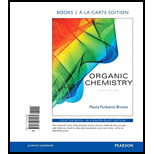
a.
Interpretation:
To write the products of the given reactions.
Concept introduction:
So many number of reactions are involved in the Carbonyl group. The carbonyl group is electrophilic nature, therefore it undergoes nucleophilic addition reactions.
For example carbonyl group reacts with Grignard reagent, it undergoes nucleophilic addition reactions and form unstable tetrahedral intermediate by the elimination of leaving group. Addition of hydrogen ion to the carbonyl carbon to form alkoxide ion. By the protonation of alkoxide ion forms alcohol.
b.
Interpretation:
To write the products of the given reactions.
Concept introduction:
So many number of reactions are involved in the Carbonyl group. The carbonyl group is electrophilic nature, therefore it undergoes nucleophilic addition reactions.
For example carbonyl group reacts with Grignard reagent, it undergoes nucleophilic addition reactions and form unstable tetrahedral intermediate by the elimination of leaving group. Addition of hydrogen ion to the carbonyl carbon to form alkoxide ion. By the protonation of alkoxide ion forms alcohol.
c.
Interpretation:
To write the products of the given reactions.
Concept introduction:
So many number of reactions are involved in the Carbonyl group. The carbonyl group is electrophilic nature, therefore it undergoes nucleophilic addition reactions.
For example carbonyl group reacts with Grignard reagent, it undergoes nucleophilic addition reactions and form unstable tetrahedral intermediate by the elimination of leaving group. Addition of hydrogen ion to the carbonyl carbon to form alkoxide ion. By the protonation of alkoxide ion forms alcohol.
d.
Interpretation:
To write the products of the given reactions.
Concept introduction:
So many number of reactions are involved in the Carbonyl group. The carbonyl group is electrophilic nature, therefore it undergoes nucleophilic addition reactions.
For example carbonyl group reacts with Grignard reagent, it undergoes nucleophilic addition reactions and form unstable tetrahedral intermediate by the elimination of leaving group. Addition of hydrogen ion to the carbonyl carbon to form alkoxide ion. By the protonation of alkoxide ion forms alcohol.
Want to see the full answer?
Check out a sample textbook solution
Chapter 16 Solutions
Organic Chemistry, Books a la Carte Edition (8th Edition)
- Which of the products is correct for this reaction listed? Z-alkene, E-alkene, both, none?arrow_forwardWhat are the products of the following reaction (drawing) ?arrow_forwardDraw the major organic product(s) of the following reactions including stereochemistry when it is appropriate. ● CEC • Use the wedge/hash bond tools to indicate stereochemistry where it exists. • If no reaction occurs, draw the organic starting material. Separate multiple products using the + sign from the drop-down menu. MULL ? H₂O/H₂SO4/HgO ChemDoodleⓇ Sn [Farrow_forward
- Is this the correct product? did I add the OH to the correct substituent?arrow_forwardWhat is the correct product from the reaction showen in the picturearrow_forwardDraw the organic product of the following reaction. CH3 m-CICgH,CO;H • Use the wedge/hash bond tools to indicate stereochemistry where it exists. • If the reaction produces a racemic mixture, just draw one stereoisomer. • If more than one product is possible, only draw the major product. opy astearrow_forward
- TReview TOpics] [References Draw a structural formula for the major product of the reaction shown. CH3 CH3CHCH=CH2 Show product steréochemistry IF the reactant alkene has both carbons of the double bond within a • Do not show stereochemistry in other cases. If the reaction produces a racemic mixture, just draw one stereoisomer. C P opy aste C.arrow_forwardFill in the boxes to predict the reactants, reagents, or products. Pay attention to stereochemistry!arrow_forwardIn this addition reaction, which stereoisomer is produced?arrow_forward
- Draw the cycloalkene that would react with the reagent given to account for the product formed. ? + H₂O H₂SO4 CH3 ▼ • You do not have to consider stereochemistry. • You do not have to explicitly draw H atoms. • In cases where there is more than one answer, just draw one. » [ ]# CH3 ? OHarrow_forwardCurved arrows are used to illustrate the flow of electrons. Follow the arrows and draw the intermediate and product in this reaction. Include all lone pairs. Ignore stereochemistry. Ignore inorganic byproducts. H Draw Tetrahedral Intermediate Draw Product Qarrow_forward08.20b 1) ВН, THF 2) H,O2, NaOH Modify the given carbon skeleton to draw the major product(s) of the given reaction. If a racemic mixture of enantiomers is expected, draw both enantiomers. Note: you can select a structure and use Copy and Paste to save drawing time. CHarrow_forward
 Organic ChemistryChemistryISBN:9781305580350Author:William H. Brown, Brent L. Iverson, Eric Anslyn, Christopher S. FootePublisher:Cengage Learning
Organic ChemistryChemistryISBN:9781305580350Author:William H. Brown, Brent L. Iverson, Eric Anslyn, Christopher S. FootePublisher:Cengage Learning
